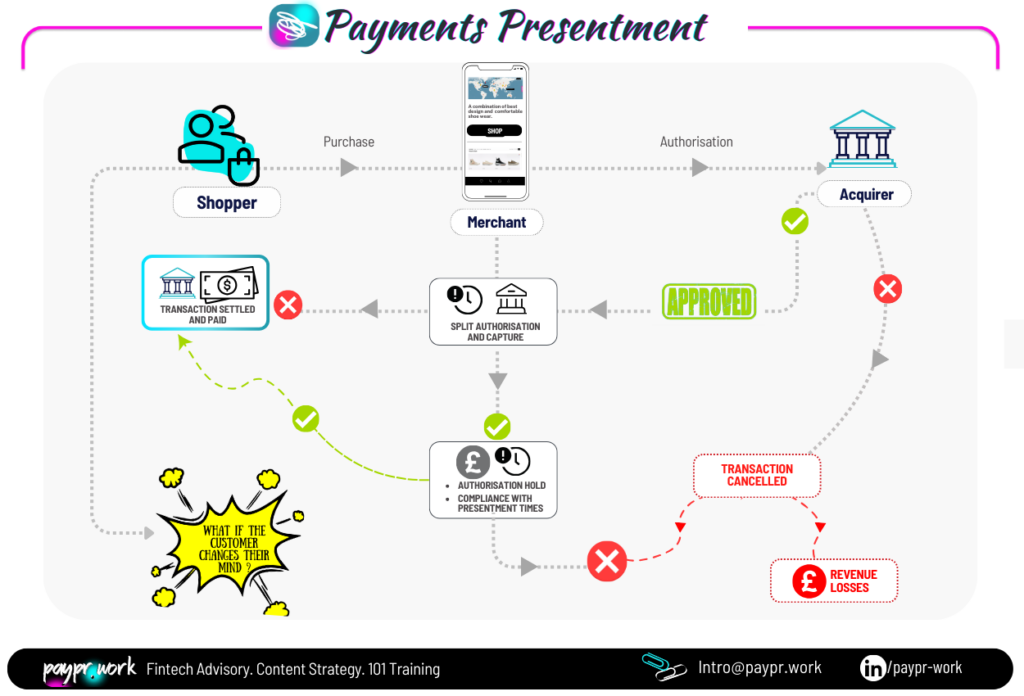
Settlement cycles are changing. Where T+1 (next-day) or T+2 settlements were once standard, several markets are now moving toward T+0, namely same-day settlement.
This shift is being driven by a mix of infrastructure upgrades, regulatory initiatives, and market demands for greater liquidity and reduced risk. India, for example, has introduced optional T+0 settlement for its top 500 listed stocks. In retail payments, real-time payment systems like PIX (Brazil), UPI (India), and SEPA Instant (EU) have set new expectations around speed and availability of funds.
But this isn’t just about speed. It’s about redefining how presentment fits into the broader payment flow.
Presentment is a foundational—but often overlooked—component of the payment lifecycle. It refers to the merchant’s formal submission of a transaction to their acquiring bank for settlement. In other words: authorisation secures the intention, but presentment triggers the actual movement of fun
Despite its centrality, presentment often receives limited attention outside of payment operations teams. But with industry-wide shifts toward faster settlement, particularly the global momentum toward T+0 (same-day) processing, this once-back-office step is fast becoming a strategic focal point.
Let’s look at the traditional card payment flow:
1️⃣ Authorisation / Pre-authorisation
2️⃣ Batching
3️⃣ Clearing / Presentment / Capture
4️⃣ Funding / Settlement
Following an approved authorisation, the merchant places a temporary hold on the customer’s account. This hold is not a charge—it simply reserves the funds and provides conditional assurance. To transform that hold into payment, the merchant must present the transaction for settlement—typically within a scheme-defined timeframe, known as the presentment window.

If the merchant fails to present within that window, several risks arise:
Presentment, therefore, is not just procedural—it’s financially consequential.
Globally, the settlement landscape is evolving. Several markets are moving from T+1 (next-day settlement) toward T+0, where transactions are settled on the same day they are executed.
India has taken the lead, recently rolling out optional T+0 settlement for its top 500 stocks. Meanwhile, conversations in Europe suggest a possible leapfrog directly to T+0 for certain instruments. These moves reflect a broader push for efficiency, liquidity, and reduced counterparty risk.
But what does this mean for presentment?
In a T+0 environment, the authorisation-presentment lag must be compressed—or eliminated entirely. For merchants and payment processors, this shift brings both opportunity and pressure:
In this new paradigm, presentment can no longer be a deferred task. It must be treated as part of a continuous, tightly managed payment lifecycle.
Certain sectors will continue to rely on pre-authorisation and delayed capture models—though they too will need to adapt if T+0 becomes standard:
🏨 Hospitality – Card authorised at check-in; presentment post-checkout
🚗 Car rental – Hold at booking or pickup; capture on vehicle return
🛍️ Ecommerce – Pre-auth at checkout; presentment after order is shipped
These use cases are valid, but increasingly depend on clear coordination between operational and payments teams to avoid reversals and customer confusion.
T+0 introduces a structural shift that compresses the overall payment lifecycle, and presentment is one of the most affected stages. Therefore, getting the presentment windows right in this context means rethinking:
As the industry embraces faster settlement cycles, presentment is no longer a hidden middle step—it’s a front-line issue that can unlock or undermine financial performance. Whether you operate in traditional retail, ecommerce, or platform-based ecosystems, getting presentment right—at the right time—is essential.
Paypr.work blends payment knowledge and custom research into a simplified yet insightful narration. Our narratives feature visually engaging designs that break down both fundamental and complex payment jargons into bite-sized, repetitive micro-concepts to promote better comprehension and retention.
Sign up for a Paypr.work Premium Membership to exclusively access all of our payment resources, including our full articles, industry insights, ecosystem maps, reports, videos, and our unique library of bespoke infographics.
Don’t miss out— sign up to learn payments in a captivating way!



You have provided so much light and knowledge in a fascinating world. You definitely bring the fun to Fintech like no one else and actually know what you are talking about! Thanks goodness for you😁!

Vice President Global Product Expansion, Shift4
Impressive, congratulations Sandra and Team Paypr.work. The detail in each of your 100+ infographics is outstanding and showcases your expertise well… Continued success for this remarkable work!

LinkedIn Strategist | Digital Transformation Leader

Host of Heads Talk
Your diagrams have the ability to explain the most complicated of topics in way that can be understood by anyone. Not many people have the ability to create self-explanatory visuals, so keep doing your magic 🔥🔥🔥!

CEO & Co Founder of CLOWD9
Your content is so informative, accurate, and fabulously presented in infographics that always attract great attention. Your visuals naturally spark strong engagement regardless of the LinkedIn algorithms !

B2B Marketing, Marqeta
The depth of Paypr.work knowledge and skill sets are truly impressive. Their ability to combine deep industry expertise with well-depicted visual is pretty unique. I strongly recommend Sandra and Paypr.work !

Director EMEA Payment Solutions, Marriott International
👏👏 👏👏 👏👏 I always love your content and in fact, I am so happy for all of us in the industry… we’re lucky to have you sharing your payment wisdom with us 🤓… thank you! Keep up the great work.

Strategic Accounts Director, Truelayer | Payments and Fintech Geek
Merci Sandra pour ta facilité à vulgariser le paiement via de simples dessins, qui me surprendront toujours. Pour ceux qui ne connaissent pas son travail, je vous invite à suivre Paypr.work [ˈpeɪpəwəːk]!

Product Manager Paiement, Maisons du Monde
Your enthusiasm and ability to simplify Payments is so refreshing and literally shines through! Sandra and her team research, write content and create some stunning infographics for the payments industry….

Chief Operations Officer, Clowd9
Keep up the good work and know that your hard work and dedication is so inspiring for all of us. You are truly doing an incredible job and your consistent efforts don’t go unnoticed.

Chief Community Officer, NORBr | Redefining Payment Infrastructure | Linkedin Top Voice
Your posts are a masterclass in how payments have evolved from a basic utility to a strategic asset. Your ability to simplify this complexity and provide strategic direction along with implementation support is so invaluable. The clarity and depth you provide are exactly what this fast-evolving industry needs.

Chief Commercial and Operations Officer, Soffid
The mechanics of all things payment are a black box for most industry stakeholders. With the help of their well researched and designed infographics, Sandra and her team at Papr.work demystify complex flows and create awareness about the factors that play a role in the end to end processes.

Paul van Alfen | Managing Director Managing, Up in the Air - Travel Payment Consultancy
Your Paypr.work subscription gets you full access to all Paypr.work content in 1 place including: our weekly new payments articles, our infographic blog, exclusive discounts on all the services that Paypr.work has to offer and the opportunity to collaborate on free infographic to promote your knowledge/value proposition and more. The content is for personal use and cannot be copied, reproduced, redistributed, altered, modified, shared publicly or with third-party nor can derivatives of the work be created. The user may share content that is available through the free blog access subject to crediting Paypr.work with the attributions.